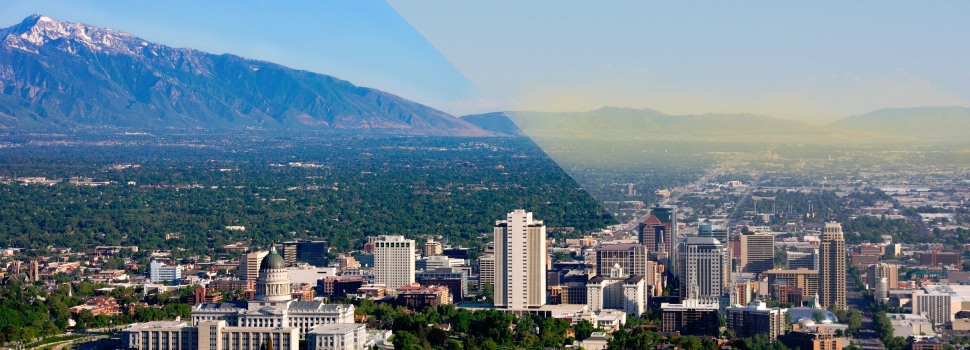
Air Apparent: Improving Utah’s air quality
Towering peaks—frosted in winter white, robed in summer green—provide a stunning backdrop for those who work and live along the Wasatch Front. These same summits, however, contribute to a not-so-pretty aspect of working and living in Utah: poor air quality.
Winter’s murky inversions hover with particulates called PM2.5. Summer’s hazardous ozone simmers with pollutant chemical reactions. With frequent high-pressure weather conditions, emissions from several sources and the majority of the population tucked into mountain valleys, Utahns are exposed to dangerous air quality.
Dr. Scott Williams, pediatrician and executive director of HEAL Utah, a health and environment advocacy group, explains, “We have too many days of the year when we exceed unhealthy thresholds. Those particles on the bad days stay there and can create health problems for those with respiratory or heart conditions. The key measure is how many bad days we have, and we’re still out of attainment with federal requirements.”
The state Division of Air Quality is warning that the Salt Lake Valley may not be able to attain air quality compliance by a 2019 federal deadline, which could bring costly legal penalties, according to a recent article in The Salt Lake Tribune.
Beyond what scientists and experts are saying, everyday residents are paying attention to air quality. Envision Utah recently conducted in-depth qualitative and quantitative statewide research to address growth in Utah. One of the key findings in its report, “Utahns Vision for 2050, Air Quality,” stated, “For Utahns, poor air quality is the greatest negative attribute of their quality of life and one of their strongest concerns.”
Business leaders are also noticing the air’s impact on the workforce. “Air pollution, I really believe, is the No. 1 limitation to economic growth along the Wasatch front,” says Hanko Kiessner, CEO of Packsize International and co-founder of Leaders for Clean Air. “It limits [business leaders] to recruit talent to the state. We hear from other CEOs that they’re losing a certain number of employees to air pollution. They’re moving out of the state; they don’t want to expose their kids to this health hazard. The reverse happens with Millennials. They Google life quality in Utah, come up with air quality, then they don’t want to come here.”
With the anticipated near-doubling of the population by 2035, clearly, we gotta’ clear the air. The good news is, the momentum for better air is already underway.
Getting behind the [right] wheel
It all starts with understanding where the bad air comes from. The Envision Utah report breaks down the numbers: Cars and trucks cause 55 percent of winter emissions. “Area sources,” or homes and businesses (including heating, household chemicals, paints, food production, etc.) account for 27 percent of winter emissions. Non-road mobile sources (construction equipment, airplanes, boats, lawn mowers, snow blowers, etc.) cause 10 percent of winter emissions. Finally, “point sources,” the power and industrial plants, are responsible for just 8 percent of winter emissions.
The numbers are surprising to many. “People don’t like seeing smokestacks; they think that’s what’s causing the problem,” said HEAL Utah’s Williams. “Industry is part of the problem, but it’s the hundreds of thousands of vehicles on the road. You need to change the technology or the behavior of people who drive them.”
So what does this mean? Should Utahns drive less? Telecommute more? String errands together? Put a carpool together? Ride TRAX? Take the bus?
Yes. Yes. And yes. But beyond these worthwhile efforts, we also need to focus on the vehicles themselves. The Utah Legislature recently passed HCR 18, a joint resolution encouraging Utahns to weigh smog ratings when shopping for cars. Envision Utah COO Ari Bruening explains, “On the window sticker, there’s the MPG rating—there’s also a smog rating there. You want to get the highest smog rating you can. It makes a bigger difference than you think.”
Thought leaders like Kiessner want to raise the bar even higher. They envision a day when every Utahn drives a zero emission car. Kiessner says, “By far the best solution is to switch the entire system over to zero emissions. Then we don’t need to change our behavior. We have the tech for that. It’s available today.”
Currently, electric vehicles account for less than 1 percent of vehicle sales, whereas SUV and small truck sales made up over 70 percent of new vehicle sales in the first half of 2017, according to The Salt Lake Tribune.
Kiessner praises zero emission vehicles, saying, “These cars don’t need maintenance like normal oil changes—there are no pistons moving up and down. No more fuel costs, and electricity is so inexpensive in Utah. They have more torque; they’re actually fun to drive. Once people are zero emission, they can drive all day long and not pollute.” And he would know. Not only does he drive a zero emission car in his personal life, but he has also transitioned his company’s local fleet to zero emission vehicles and installed free charging stations for employee use.
Parking the car
In getting from here to there, experts are also looking at ways to minimize the need for cars. Williams says, “When we look at some of the new development around the Point of the Mountain, we look at things like, are those being designed around public transportation, electric vehicle charging stations, walkability—the things that keep people out of their cars?”
A long-time proponent of environmental initiatives, the University of Utah recently increased its efforts by organizing an Air Quality Task Force to identify short- and mid-term steps, what it calls “necessary changes,” to do its part in helping the Salt Lake Valley attain air-quality standards. The task force delivered a report in 2015, “Improving the Air We Breathe: Emission Mitigation Strategies for the University of Utah,” which it has been using as an implementation guide for the past few years.
To lessen the impact of commuting, Myron Willson, deputy chief sustainability officer for the University of Utah, says, “Almost half of our people come to campus in something other than a car. A lot take TRAX and the bus. We also have quite a larger percentage who walk or bicycle.
“We want to work on policies that make it easier for you to get out of your car. We’ve hired an active transportation manager for campus. We’re working on bike paths, and we’re working on an electric bike community discount purchase program. We’re on a hillside, and we recognize that some people might bike here, but they don’t want to get here all sweaty or they can’t make it up the hill. Electric bikes weren’t available a few years ago; it’s a new solution.”
The school is also adding an electric shuttle to its fleet and is even looking at ways to encourage walking, including planting more shade trees along pathways and improving routes between sections of campus.
Cooling off & heating up
Experts are also addressing how to make buildings and homes more efficient, since they contribute to nearly 30 percent of the air quality problem—a percentage that could likely get higher. “Today, cars contribute most of the pollution but over time as cars get cleaner, and we build more buildings, area sources are going to become the largest contributors to air quality,” explains Bruening. “You build a building, it’s going to be there for 100 years-plus. We need to think carefully about what we can do to make them more energy efficient. And our homes—they all have two smoke stacks on the front, sending emissions from the water heater and furnace. Any given house—that’s not a ton of emissions. But when you get hundreds of thousands of homes, that adds up.”
Kiessner adds, “We need to stop burning natural gas in favor of heating and cooling heat-pump technology that works with electricity. And if electricity is generated with solar energy and wind, then we have a completely sustainable system.”
The University of Utah is taking a significant step in that direction. “The new Gardner Commons building will be all electric, eliminating the burning of natural gas,” says Willson. “When we pair that with the solar panels on the roof and renewable energy that we purchase, this will be our first building that will be the equivalent of a Subaru PZEV, a partial zero emissions building.”
To address other sources of emissions, the university is turning to green cleaning products and paints that have fewer chemicals. The school is transitioning to electric equipment, and in the meantime, Willson explains that on “mandatory action days” when air quality is poor, its landscaping crews halt work with gas-powered equipment.
Working together
In 2016 and 2017, the Utah Legislature took steps forward in supporting clean air initiatives. The government passed the smog-rating HCR 18; it continued business and home tax credits for wind and solar energy installation; and it worked closely with large oil refineries to ensure the transition to cleaner Tier 3 gas production by 2019. In this year’s Legislative Session, legislators passed a bill mandating diesel vehicle emission testing in counties that have emission testing; they also passed a bill that will pave the way for Tesla to sell its electric vehicles in Utah.
However, for many watching the air quality dilemma, the legislature has taken a few steps back. In 2017, the Legislature discontinued tax credits for zero emission cars. This year, it added an annual fee for electric and hybrid vehicles to bolster funds for transportation projects. In 2016, it failed to pass a resolution calling for new home building code updates that would have improved energy efficiency.
Working closely with the legislature, Williams, who as a pediatrician decided to become involved with HEAL Utah because he could see the negative impact of environmental issues among his young patients, urged Utahns to get involved. “Policymakers can’t be expected to solve the whole problem. We all have to take ownership.”
The U’s Willson concurrs, reminding Utahns that this is a group effort. “We need organizations to help, nonprofits to help raise a ruckus and show us what we can do better, but we can also do a lot to look inward. Companies, institutions, individuals—we can all adopt an attitude that we’re part of the problem, and we’re also a part of the solution.”
And for a thriving Utah economy expected to gain from increased population, there’s no better time than now for everyone to be part of that solution.





